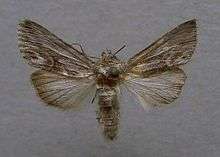Calophasia platyptera
Calophasia platyptera (antirrhinum brocade) is a moth of the family Noctuidae. It is found in Europe, the Near East, western Sahara, Morocco, Algeria, Tunisia.
| Calophasia platyptera | |
|---|---|
 | |
| Scientific classification | |
| Kingdom: | Animalia |
| Phylum: | Arthropoda |
| Class: | Insecta |
| Order: | Lepidoptera |
| Superfamily: | Noctuoidea |
| Family: | Noctuidae |
| Genus: | Calophasia |
| Species: | C. platyptera |
| Binomial name | |
| Calophasia platyptera (Esper, [1788]) | |
| Synonyms | |
| |
Technical description and variation
C. platyptera Esp. (= canterius Vill., tenera Hbn.) (29 b). Forewing pale grey, with slight partial darker dusting; the veins finely dark; a thin black streak on submedian fold from base traversing a faintly paler claviform stigma; lines marked by oblique costal strigae and double curved marks on inner margin, the outer line there preceded by a curved dark grey cloud ; terminal area with a double series of black streaks in the intervals interrupted by a pale submarginal line; fringe chequered fuscous and grey; hindwing dingy grey in female, whitish in male ; the terminal half fuscous in female, reduced to a narrow grey border in male— ab. subalbida Stgr. (29 c), (queried by him as possibly only the summer brood) from Sicily and Algeria is much whiter, the dark markings of the forewing obsolescent; the hindwing nearly wholly white; — olbiena Dup. (29 c) has the dark markings of forewing intensified and blackish brown. Larva like that of lunula, whitish with yellow lines and transverse black blotches; but these are smaller and more numerous, and the yellow lines are more interrupted at the segmental incisions [1] The wingspan is about 30 mm.
Biology
Adults are on wing from early spring to November. There are multiple generations per year.
The larvae feed on the flowers and leaves of Antirrhinum and Linaria species.
References
- Warren. W. in Seitz, A. Ed., 1914 Die Großschmetterlinge der Erde, Verlag Alfred Kernen, Stuttgart Band 3: Abt. 1, Die Großschmetterlinge des palaearktischen Faunengebietes, Die palaearktischen eulenartigen Nachtfalter, 1914
